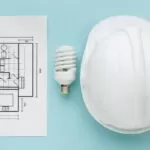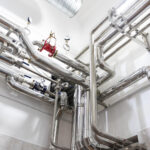Sustainable MEP engineering design is crucial for building owners in Texas who aim to not only meet environmental standards but also optimize energy efficiency and reduce operational costs. In this article, we will explore eight practical and actionable sustainable design strategies for MEP (Mechanical, Electrical, and Plumbing) engineering that can benefit business owners in the Lone Star State.
Table of Contents
1. Efficient HVAC Systems
Investing in energy-efficient Heating, Ventilation, and Air Conditioning (HVAC) systems is a cornerstone of sustainable MEP engineering design. Texas, known for its scorching summers, demands robust HVAC systems that can effectively cool indoor spaces while minimizing energy consumption. Opt for systems with programmable thermostats, high Seasonal Energy Efficiency Ratio (SEER) ratings, and regular maintenance to ensure peak performance.
2. Smart Lighting Solutions
Lighting plays a significant role in a building’s energy consumption. For business owners in Texas, adopting smart lighting solutions can lead to substantial energy savings. Implementing LED lighting, motion sensors, and automated controls can reduce electricity usage and create a more sustainable environment. Additionally, natural daylight harvesting techniques can be employed to maximize the use of natural light, further decreasing dependency on artificial lighting during the day.
3. Water Conservation Measures
Texas faces periodic water shortages, making water conservation a pressing concern. Sustainable MEP engineering design emphasizes the integration of water-efficient plumbing systems, low-flow fixtures, and smart irrigation systems for landscaping. Building owners can install water recycling systems to reuse rainwater and graywater, contributing to both water conservation and cost reduction.
4. Renewable Energy Integration
Harnessing renewable energy sources is a key aspect of sustainable MEP engineering in Texas. Business owners can explore options such as solar panels and wind turbines to generate on-site renewable energy. By tapping into Texas’ abundant sunlight, solar panels can significantly offset electricity costs. Moreover, leveraging state incentives and federal tax credits can make the initial investment more financially feasible for building owners.

5. Building Envelope Optimization
Efficient insulation and well-designed building envelopes are essential for maintaining a comfortable indoor environment while minimizing energy loss. In Texas, where temperatures can vary drastically, building owners should prioritize proper insulation, high-performance windows, and airtight construction. This approach not only enhances energy efficiency but also reduces reliance on HVAC systems, contributing to long-term sustainability.
6. Sustainable Material Selection
Choosing sustainable and environmentally friendly materials during the construction or renovation process is a prudent strategy for building owners in Texas. Opting for recycled or locally sourced materials not only reduces the environmental impact but also supports the local economy. Sustainable MEP engineering design encourages the use of materials with low embodied energy and a longer lifespan, promoting durability and minimizing waste.
7. Energy Monitoring and Management Systems
Implementing advanced energy monitoring and management systems can empower building owners in Texas to make informed decisions about energy consumption. Real-time data on energy usage allows for proactive measures to optimize performance and identify areas for improvement. Additionally, automated energy management systems can adjust settings based on occupancy patterns, ensuring efficient resource utilization.
8. Lifecycle Analysis and Maintenance
A holistic approach to sustainable MEP engineering design involves considering the entire lifecycle of building systems. Conducting a lifecycle analysis helps identify the environmental impact of different components and materials over their lifespan. Furthermore, regular maintenance and timely upgrades contribute to the longevity and efficiency of MEP systems, preventing unnecessary replacements and reducing overall environmental impact.
Conclusion
In conclusion, embracing sustainable MEP engineering design offers tangible benefits for building owners in Texas. From optimizing HVAC systems and implementing smart lighting solutions to integrating renewable energy sources and prioritizing water conservation, these strategies contribute to both environmental stewardship and cost savings. By adopting these practical measures, business owners can create more sustainable, energy-efficient buildings that align with Texas’ growing commitment to environmental responsibility. Investing in sustainable MEP engineering design is not just an eco-friendly choice; it is a strategic decision that can positively impact the bottom line while fostering a greener future for the Lone Star State.




